Abstract
Gold is a vital strategic resource for many countries. The Laozhaiwan area is an important gold resource base in Yunnan Province and even nationwide. Conducting mineral resource exploration in this region to increase gold reserves is of great significance. The application of remote sensing technology in mineral resource exploration is a green and efficient technical approach, which has been widely utilized in the field of mineral resource prospecting. This study selects the Laozhaiwan area in the southeastern part of Yunnan Province as the research region. Linear and ring structures were extracted using the remote sensing visual interpretation method based on Sentinel-2A multispectral data. Additionally, Sentinel-2A, ASTER, and ZY1-02D data were used to extract iron-stained, hydroxyl, silicification, and limonite alteration information through Principal Component Analysis (PCA) and Spectral Angle Mapper (SAM) methods. Additionally, 50 linear structures and 12 ring structures were extracted. A comprehensive analysis of geological data reveals that alteration minerals and linear-ring structures are closely related to mineralization, providing valuable indicators for mineral resource exploration. By comprehensively analyzing the alteration information and remote sensing interpretation results of the linear-ring structures, two prospective areas for mineral exploration were delineated. Field investigations and petrographic studies confirmed the reliability of remote sensing technology in mineral exploration. The mineral exploration method based on multi-source remote sensing technology can clearly reflect various alteration information and linear-ring structural data. It provides remote sensing geological insights for geological survey work and has great application potential in the field of mineral resource exploration.
1. Introduction
Gold, as a critical strategic resource, plays an indispensable role in global economic stability. In recent years, with the turbulence in global affairs, many countries have turned to storing gold as a means of risk mitigation, leading to a sharp increase in both gold consumption and prices. Consequently, the exploration and development of gold deposits to bolster national reserves have gained paramount significance [1]. Yunnan Province, characterized by intense geological activity and structurally complex terrain, hosts abundant magmatic–hydrothermal pathways conducive to mineralization. This geological endowment has positioned the province as a hub for diverse mineral resources. Notably, within the famed “Golden Triangle” metallogenic belt (spanning Yunnan, Guizhou, and Guangxi), the Laozhaiwan gold deposit in southeastern Yunnan stands out as a medium-to-large-scale Carlin-type gold deposit [2]. By 2010, this deposit had achieved an annual ore processing capacity exceeding 600,000 tons [3], solidifying its status as a vital gold resource base for Yunnan and the broader nation. However, the region has a high vegetation coverage, and the terrain is predominantly mountainous, posing challenges to traditional geological exploration methods, such as high workload and low operational efficiency. Overcoming the above challenges and developing more efficient methods to identify gold mineralization is an important research direction.
Alteration of surrounding rocks is closely related to host strata, structures, and magmatic activities. Remote sensing technology can be used to extract alteration information, which plays a significant role as an indicator in geological mineral exploration [4,5,6]. A large number of scholars have already utilized multispectral remote sensing technology to extract alteration minerals. In regions such as Yunnan [7,8,9], Sichuan [10], and Tibet in China [11,12,13,14], multispectral l data from sources like ASTER, Landsat-8, Sentinel-2, and WorldView-3 have been used to extract alteration mineral information related to mineralization, successfully guiding geological survey work. The multispectral data used in these studies primarily include TM [15,16], ETM+ [17,18], ASTER [7,19,20], Landsat-8 [21,22,23], Sentinel-2 [24,25], and WorldView-3 [26,27,28], among others. However, multispectral data have the limitation of lower spectral resolution, and their alteration mineral extraction mainly focuses on mineral groups, making it difficult to accurately identify specific types of alteration minerals. As a result, the ability to extract specific alteration minerals with fine detail still requires improvement [29]. With the rapid development of remote sensing technology, hyperspectral data, compared to multispectral data, offer higher spectral resolution, allowing for more precise diagnostic analysis of the spectral characteristics of most alteration minerals. As a result, hyperspectral data have achieved excellent application results in lithology identification and alteration information extraction, significantly enhancing the remote sensing observation capabilities and the ability to distinguish surface features. Over the past decade, these advancements have established hyperspectral remote sensing as a focal point in geological remote sensing research [30,31]. Among them, airborne hyperspectral data mainly include HyMap [32], AVIRIS [33], and CASI/SASI [34], but these have high acquisition costs and long acquisition cycles. On the other hand, satellite hyperspectral data, such as Hyperion [35] and TG-1 [36], have narrower spectral bands and limited data acquisition capabilities, and no new data are currently being acquired. On September 12, 2019, China successfully launched the ZY1-02D remote sensing satellite [37], which effectively addresses the above-mentioned issues and holds significant research importance. However, due to the short time since the launch of the ZY1-02D hyperspectral satellite, research on alteration mineral extraction using ZY1-02D hyperspectral data is still limited.
Current research on Carlin-type gold deposits using remote sensing technology predominantly relies on ETM data for extracting alteration information [38,39]. In this study, we focus on the Laozhaiwan gold deposit area in southeastern Yunnan. Using Sentinel-2A, ASTER, and ZY1-02D remote sensing satellite data, we interpret the linear-ring structures in the region and extract alteration mineral information closely related to gold mineralization. The main research contents are as follows: (1) Based on Sentinel-2A remote sensing satellite data, linear-ring structures in the region were mapped through visual interpretation methods. (2) Using Sentinel-2A and ASTER multispectral data, alteration information including iron-stained, hydroxyl, and silicification was extracted via Principal Component Analysis (PCA). (3) Using ZY1-02D hyperspectral remote sensing data, limonite mineralization information was extracted through the Spectral Angle Mapper (SAM) method. (4) Based on the characteristics of the Laozhaiwan gold deposit, new prospective areas for mineral exploration were delineated. The effectiveness of the multi-source remote sensing technology in mineral exploration was then validated through field investigations and rock and mineral identification.
2. Geological Setting
The southeastern Yunnan region is located at the corner of the Youjiang Basin, within the Yunnan–Guizhou–Guangxi “Golden Triangle” area. Tectonically, it lies at the junction of the southwestern edge of the Yangtze Block and the Cathaysia Block. This region is widely distributed with carlin-type gold deposits (or occurrences) of varying scales, making it an important gold resource extraction area in China (Figure 1) [40]. These deposits exhibit multi-stage and multi-stratigraphic mineralization characteristics, mainly occurring in the Triassic strata of the Upper and Middle Paleozoic, as well as the Mesozoic. Among them, the Triassic and Permian strata are predominant, while a few are found in the Carboniferous and Devonian strata. The east–west trending extensional fault zones are the primary controlling structures for gold mineralization in this area [41].
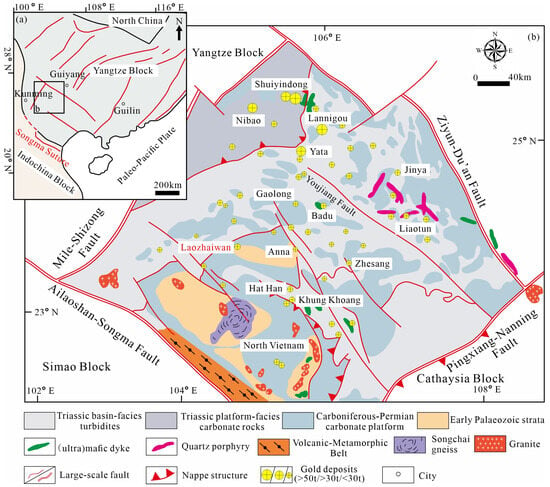
Figure 1.
Geological sketch. (a) Tectonic location map of the Youjiang Basin; (b) distribution map of gold deposits (modified from [42,43,44]).
The study area spans from 104°49′E to 104°55′E and from 23°43′N to 23°51′N, with the Laozhaiwan gold deposit located in the northern part of this region. The Laozhaiwan gold deposit in southeastern Yunnan is a representative gold deposit in the Yunnan–Guizhou–Guangxi gold metallogenic belt, with its stratigraphy and lithology shown in Figure 2. The exposed strata in the region, from oldest to youngest, are as follows: the Upper Cambrian Tangjiaba Formation and Cambrian–Ordovician Bolaitian Formation, the Lower Ordovician Shanjianshan Formation and Lower Ordovician Laozhai Formation, and the Lower-Middle Devonian Pojiao Formation. Among these, the Lower-Middle Devonian Pojiao Formation is the main ore-bearing horizon in the region. The lithology primarily consists of thick, massive, fine-grained quartz sandstone with gray, gray-white, and brown-yellow colors. Alteration phenomena such as silicification, limonite mineralization, and clayization are commonly developed. The gold deposit in the area is a typical Carlin-type deposit. The main sulfide minerals include pyrite, stibnite, marcasite, orpiment, and arsenopyrite. The gangue minerals are primarily quartz, followed by calcite, dolomite, feldspar, and sericite, among others. The surrounding rocks in the mining area exhibit intense alteration, with the alteration of the proximal host rocks showing characteristics of a low- to medium-temperature hydrothermal assemblage. These alterations are notably developed along structural belts. The hydrothermal alteration types during the mineralization period mainly include silicification, pyritization, stibnite mineralization, limonite mineralization, sericitization, and clay alteration (kaolinitization, illitization). Among these, the alterations closest to gold mineralization are the first four types, particularly in the proximal host rocks [1,44].
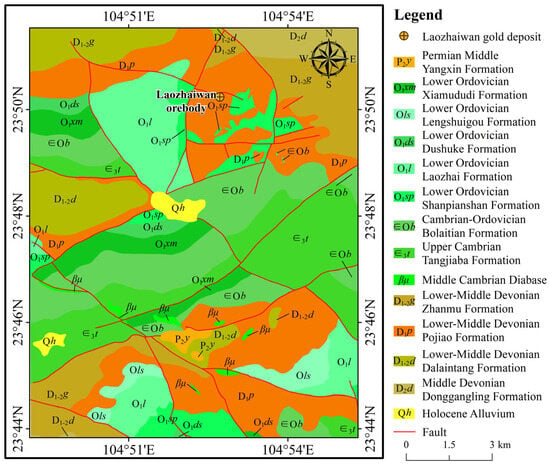
Figure 2.
Geological map of the Laozhaiwan area.
3. Materials and Methods
3.1. Remote Sensing Data
In order to obtain more comprehensive surface alteration information, this study employed multi-platform remote sensing data, including multispectral data from Sentinel-2A and ASTER, and hyperspectral data from the ZY1-02D satellite. By leveraging the complementary nature of different remote sensing datasets and their mutual validation, more abundant and effective surface alteration information could be acquired.
Sentinel-2 is a multispectral imaging satellite launched by the European Space Agency (ESA) on 23 June 2015, specifically designed for Earth observation. Its primary mission is to provide high-resolution optical imagery for land monitoring [45]. The spectral wavelength range of the data spans from 0.433 μm to 2.28 μm, consisting of 13 spectral bands. Among these, 4 bands have a spatial resolution of 10 m, 6 bands have a spatial resolution of 20 m, and 3 bands have a spatial resolution of 60 m (Table 1) [46]. Sentinel-2 data can be effectively utilized for extracting iron-stained alteration information [24,25], and its 10-m spatial resolution further facilitates detailed surface observations.

Table 1.
Parameters of Sentinel-2A, ASTER, and ZY1-02D data.
ASTER (Advanced Spaceborne Thermal Emission and Reflection Radiometer) is an advanced optical sensor onboard the TERRA satellite, developed through a collaboration between the United States and Japan, and launched on 18 December 1999. The data has a wider spectral range compared to most remote sensing datasets, spanning from 0.52 μm to 11.65 μm. It consists of 14 spectral bands, including 3 visible-near infrared (VNIR) bands with a spatial resolution of 15 m, 6 shortwave infrared (SWIR) bands with a spatial resolution of 30 m, and 5 thermal infrared (TIR) bands with a spatial resolution of 90 m (Table 1) [47,48]. Since ASTER data includes thermal infrared bands and the spectral characteristics of silicification minerals are typically exhibited in the thermal infrared range, this data can be used to extract silicification alteration information [49,50].
The ZY1-02D satellite is an optical remote sensing satellite launched by China on 12 September 2019, also known as the 5-m optical commercial satellite. It is equipped with a new-generation AHSI camera, which has 166 bands covering the visible-near infrared (VNIR) and short-wave infrared (SWIR) ranges, capable of capturing spectral information from 0.4 μm to 2.5 μm [51]. In the visible and near-infrared bands, its spectral resolution reaches 10 nanometers, while in the short-wave infrared bands, the resolution is 20 nanometers (Table 1). The high spectral resolution characteristic enables the detection of subtle differences in similar spectral curves. Additionally, the camera’s imaging swath reaches 60 km, allowing it to cover a large ground area in a single pass while maintaining a spatial resolution of 30 m [52]. Therefore, this data has stronger mineral identification capabilities compared to multispectral data such as ASTER, making it more advantageous for extracting more specific alteration mineral information.
In this study, we used three types of remote sensing data: (1) one Sentinel-2A multispectral image (2 January 2025) downloaded from the European Space Agency (ESA) (https://dataspace.copernicus.eu/, accessed on 27 January 2025); (2) one ASTER multispectral image (20 November 2003) obtained from NASA’s Earthdata website (https://search.earthdata.nasa.gov/, accessed on 12 January 2025); and (3) one ZY1-02D hyperspectral image (6 March 2021) acquired from the China Centre for Resources Satellite Data and Application. These multi-temporal, multi-resolution datasets were selected to comprehensively analyze surface alteration features in the study area. To eliminate interference and errors in the remote sensing data and improve data quality, the aforementioned datasets need to undergo essential preprocessing operations, including radiometric calibration, atmospheric correction, and geometric correction. Additionally, due to the influence of factors such as the sensor, atmosphere, and water vapor, some bands in the ZY1-02D data exhibit abnormal Digital Numbers (DN values), resulting in either the absence of certain bands or poor image quality. Therefore, band selection is required for the ZY1-02D data [53]. Based on spectral feature analysis of the ZY1-02D hyperspectral data conducted on the ENVI 5.6 platform, it was found that some bands exhibit significant abnormal Digital Numbers (DN values) due to interference from factors such as the atmosphere and water vapor. Specifically, bands 98–101 and 126–132, totaling 11 bands, exhibited characteristic noise fluctuations and need to be removed. In addition, a per-band image quality assessment revealed that bands 1–3 (visible blue), bands 102, 125, 133, and bands 161–166 (shortwave infrared) were affected by sensor noise and atmospheric scattering effects, leading to issues such as blurred image textures, significant radiometric distortion, and a substantial decrease in the Signal-to-Noise Ratio (SNR). To ensure data reliability, this study employed a systematic band selection strategy, ultimately retaining 143 valid bands (Table 2).

Table 2.
Retained bands and wavelength ranges of ZY1-02D data.
3.2. Remote Sensing Structural Interpretation Methods
In this study, linear and ring structural interpretations were conducted for the study area based on Sentinel-2A data, and a linear-ring structural map was generated.
Linear structures can reflect surface faults or fault zones, which are often considered to be related to metallogenic processes. They can serve as channels for mineralizing fluids or favorable spaces for ore deposition. Through remote sensing techniques, including adjusting the image tone, observing morphological features, and analyzing drainage patterns, linear structural information can be effectively extracted and interpreted [29,54]. The interpretation markers for linear structures can be divided into two categories: direct and indirect. The main interpretation criteria are defined as follows:
A. Direct interpretation markers: (1) Linear boundaries between Quaternary sediments and bedrock or eroded landscapes. (2) Displacement, faulting, or offset phenomena in rock layers. (3) Obvious tonal and shadow differences in vegetation coverage and rock masses on both sides of the structure in the imagery. (4) Stratigraphic discontinuities caused by tectonic activity. (5) Triangular surfaces distributed along linear features, typically representing hilltops truncated by faults.
B. Indirect interpretation markers: (1) Right-angle or acute-angle bends in river channels. (2) Linear distribution of valleys, depressions, and chain-like lakes. (3) Different geomorphological regions arranged along a straight line, such as mountain peaks and valleys aligned along a linear feature. (4) Springs occurring along linear features. (5) Different types of geomorphological units meeting in a straight or angular line.
Ring structures in remote sensing imagery typically manifest as distinct annular patterns characterized by tonal variations, unique geomorphic features, drainage distributions, or textural changes. These ring patterns may originate from geological processes such as volcanic apparatuses, magmatic centers, plutons, salt domes, and structural domes, or result from human activities including ring reservoirs, artificial forests, and various engineered structures. In mountainous areas, ring structures often appear as concentrically or arcuately distributed ridges and valleys, near-ring massifs, or intramontane basins. Some ring features are primarily identified by their internal textures or tonal contrasts that distinctly differ from the surrounding background, which can be effectively enhanced through appropriate image processing techniques. The key diagnostic indicators in remote sensing imagery include the following: (1) typical negative topography with a depressed center encircled by elevated terrain, and (2) small-scale ring structures formed by annular drainage patterns, circular mountains, and anomalous color bands.
3.3. Remote Sensing Alteration Information Extraction Methods
3.3.1. Spectral Characteristics of Alteration Minerals
The core mechanism of using remote sensing imagery to identify minerals lies in the spectral specificity of different minerals’ surfaces to electromagnetic waves. When solar radiation interacts with a mineral surface, differences in chemical composition and crystal structure cause incident light of specific wavelengths to be selectively absorbed, reflected, or transmitted. This interaction between light and matter manifests as absorption features with diagnostic significance in the spectral curve. The main characteristic parameters include absorption peak position, absorption depth, absorption area, absorption width, absorption symmetry, the first derivative of the spectrum, and the number of absorption features. Among these, absorption peak position, absorption depth, and absorption symmetry are the three core diagnostic indicators for mineral identification [55].
The spectral absorption features of minerals in the visible to shortwave infrared range (0.4–2.5 μm) are primarily influenced by two physical mechanisms: electronic transitions and molecular vibrations, which operate in different spectral intervals. In the 0.4–1.3 μm spectral range, the spectral characteristics of minerals are affected by the interaction between electrons and the crystal field, manifesting as crystal field effects, charge transfer, color center absorption due to lattice defects in metal halides, and electron transitions between the valence band and conduction band in semiconductor materials. When the spectral range extends to 1.3–2.5 μm, the absorption mechanisms shift towards the vibration modes of anionic groups, including the vibrations of water molecules (H2O), hydroxyl groups (OH−), carbonate (CO32−), and sulfate (SO4−) groups that make up the mineral [56,57,58].
The spectral absorption features of minerals in the visible to shortwave infrared range (0.4–2.5 μm) primarily arise from the photophysical interactions of key components such as Fe2+/Fe3+ ions, Al-OH/Mg-OH hydroxyl groups, and carbonate (CO32−) groups. These characteristic absorptions form diagnostic spectral bands through specific electronic transitions or molecular vibration mechanisms. The corresponding spectral absorption peak positions, associated mineral types, and spectral response parameters have been systematically summarized in Table 3.

Table 3.
Characteristic spectral bands and absorption features of common alteration minerals (modified from [59]).
3.3.2. Principal Component Analysis (PCA)
Principal Component Analysis (PCA), also known as the Karhunen–Loeve transform (K-L transform), has been widely applied by researchers to mineral deposits in various environments and for different mineral types. It can effectively extract alteration information closely related to mineralization, such as iron-stained, hydroxylation, argillization, carbonation, and silicification, from multispectral data such as TM/ETM+, ASTER, and Sentinel-2A [60,61], and has also shown promising applicability in vegetated areas [9]. As an efficient dimensionality reduction technique, PCA is widely used in remote sensing alteration information extraction due to its advantages of strong stability, fast computation speed, and significant processing results. It plays a particularly important role in mapping hydrothermal alteration minerals and delineating lithological units [62,63]. This method is based on mathematical transformation principles, achieving information separation and enhancement of specific geological features through the reorganization and transformation of the original data. In practical applications, the Crosta technique employs principal component analysis (PCA) on multiple bands, using orthogonal transformations to effectively reduce redundancy and correlation between data, thereby enhancing the target information [64].
3.3.3. Spectral Angle Mapper (SAM)
Spectral Angle Mapper (SAM) is a spectral similarity-based method for target identification. This method has been successfully applied to extract alteration information in vegetated areas with demonstrated effectiveness [9,10]. Its core principle involves assessing the similarity between a known spectral curve and a test spectral curve by calculating the angle between them. Specifically, the method treats spectral curves as vectors in a multidimensional space, quantifying spectral similarity by calculating the angle between the vectors. The smaller the angle, the more similar the spectral features. Currently, spectral matching techniques are mainly implemented in two ways: one is to directly compare the spectral curves of remote sensing images with reference curves from a standard spectral library; the other is to extract pure pixels from the image, match their spectral features with those in the standard spectral library, and determine mineral types. The calculation formula for Spectral Angle Mapper (SAM) is as follows [65]:
In the formula, X and Y represent two sets of spectral vectors.
4. Results
4.1. Structure Interpretation Based on Sentinel-2A Data
This study is based on Sentinel-2A satellite remote sensing data to analyze the spatial distribution characteristics of linear and ring structures in the Laozaiwan area of southeastern Yunnan. Through remote sensing image enhancement and structural information extraction, a total of 50 linear structures and 12 ring structures were identified, and a map of the linear-ring structural distribution was created. The interpretation results indicate that linear and ring structures are well-developed in the region (Figure 3). The linear structures mainly exhibit two dominant orientations: northeast (NE) and northwest (NW). The NE-oriented structures are characterized by stable extension and good continuity, while the NW-oriented structures are mostly manifested as cutting through the NE-oriented faults. Based on the structural cross-cutting relationships and geometric features, it can be preliminarily concluded that the NE-oriented faults formed earlier than the NW-oriented faults, reflecting the multi-phase evolution characteristics of the regional tectonic stress field. The study area contains circular structures of varying sizes, whose spatial distribution frequently intersects with linear structures. Based on regional geological analysis, we infer that this phenomenon is closely related to deep hydrothermal activity. Structural intersections typically exhibit stress release and enhanced permeability, making them favorable pathways for hydrothermal fluid migration and advantageous sites for mineral precipitation. These observations lead us to preliminarily conclude that the study area has experienced active tectonic–hydrothermal activity and possesses significant mineral potential.
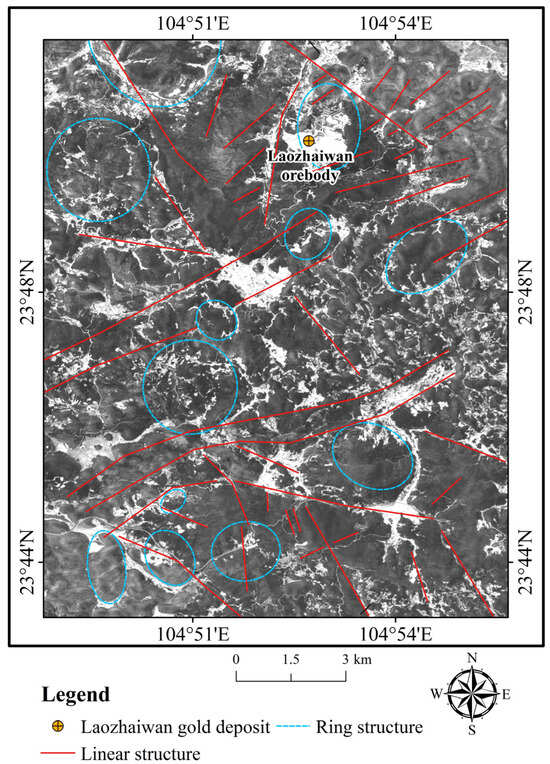
Figure 3.
Structural results extracted from the Laozaiwan area based on Sentinel-2A data.
4.2. Alteration Information Extraction Based on Sentinel-2A and ASTER Multispectral Data
Sentinel-2A satellite remote sensing data and ASTER multispectral remote sensing data have been widely used for alteration information identification. Specifically, Sentinel-2A data has been effectively applied in identifying iron-stained alteration [66], while ASTER multispectral data has also been extensively used for detecting hydroxylation and silicification alteration [67]. In the study area, alteration phenomena such as silicification, limonite mineralization, and clay alteration are commonly developed. Using these two types of remote sensing data, it is possible to extract information on iron-stained, hydroxylation, and silicification alteration.
The spectral curve of iron-staining alteration minerals exhibits strong reflection characteristics in Band 11, absorption features in Band 8A, and small reflection features in Bands 3 and 4. Therefore, a combination of Bands 3, 4, 8A, and 11 is used for principal component analysis (PCA) to extract iron-staining alteration information. The feature vector matrix for this analysis is shown in Table 4a. The hydroxyl alteration information extracted in this study is mainly associated with sericite. Sericite shows strong absorption features in Band 6 and strong reflection features in Band 4. Thus, a combination of Bands 1, 3, 4, and 6 is used for PCA to extract hydroxyl alteration information, and the feature vector matrix is presented in Table 4b. Quartz shows absorption features in Bands 10 and 12, and strong reflection in Band 14. Therefore, a combination of Bands 10, 12, and 14 is used for PCA to extract quartz alteration information, with the feature vector matrix presented in Table 4c.

Table 4.
Principal component analysis confusion matrix: (a) using Bands 3, 4, 8A, and 11 from Sentinel-2A data; (b) using Bands 1, 3, 4, and 6 from ASTER data; and (c) using Bands 10, 12, and 14 from ASTER data.
Based on the spectral characteristics of iron-staining alteration minerals, the coefficients of Bands 3, 4, and 11 should be positive, while the coefficient for Band 8A should be opposite. As shown in Table 4a, selecting PC2 can extract iron-staining alteration information. Similarly, in Table 4b, the coefficient of Band 4 should be positive, and it should be opposite to the coefficient of Band 6. Selecting PC4 can extract hydroxyl alteration information, but an inversion operation is required. In Table 4c, the coefficient of Band 14 should be positive and should be opposite to the coefficients of Bands 10 and 12. Selecting PC2 can extract silicification information. After identifying the relevant principal components, median filtering was applied to the remote sensing images to better display alteration information, with the filter kernel size set to 5. Thresholding was performed using the “mean + n standard deviation” method. Due to the rugged terrain and the widespread presence of mountain shadows, which may cause false anomalies, obvious false anomalies were manually removed based on image interpretation. The results are shown in Figure 4.
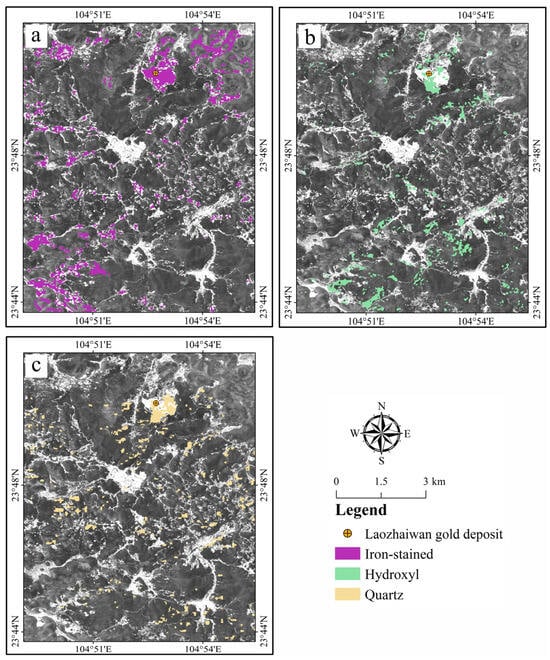
Figure 4.
Alteration information extraction results from multispectral data: (a) the image of PC2 from Sentinel-2A, with iron-stained information marked in purple; (b) the image of PC4 from ASTER data, with hydroxyl information marked in green; (c) the image of PC2 from ASTER data, with silicification information marked in yellow.
According to the results shown in Figure 4, iron-stained alteration information, hydroxyl alteration information, and silicification alteration information all exhibit concentrated distributions in the Laozhaiwan gold mining area. Iron-stained alteration information is concentrated in the northeastern and southwestern parts of the study area, with a slight distribution in the western and northwestern areas. Hydroxyl alteration information shows a clear aggregation in the southwestern part of the study area. Silicification alteration information is significantly concentrated in the Laozhaiwan gold mining area, with scattered distribution in other regions.
4.3. Alteration Information Extraction Based on ZY1-02D Hyperspectral Data
The ZY1-02D data is hyperspectral remote sensing data. Compared to multispectral remote sensing data, it offers a higher number of bands and better spectral resolution, enabling the identification of more detailed mineral alteration information. Utilizing the ZY1-02D hyperspectral remote sensing data allows for the effective extraction of alteration information related to limonite mineralization, which is closely associated with gold mineralization.
In this study, the standard spectral curve of limonite from the USGS spectral library was used. To better extract limonite alteration information, prior to applying the Spectral Angle Mapper (SAM) method, the spectral curve of limonite was resampled based on the band numbers of the ZY1-02D data. The original limonite spectral curve, which had 420 bands, was resampled to 143 bands. The limonite alteration information was extracted using the Spectral Angle Mapper (SAM) method. After multiple experimental trials, a threshold of 0.32 was ultimately determined for the operation. The results are shown in Figure 5.
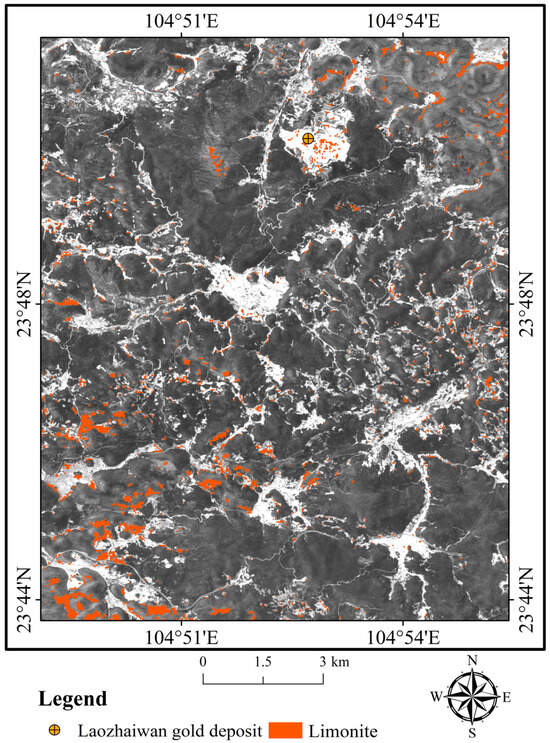
Figure 5.
Limonite mineralization alteration information results based on ZY1-02D data.
According to the results shown in Figure 5, limonite mineralization alteration information is concentrated in the southwestern part of the study area and the Laozhaiwan gold mining area, with a more scattered distribution observed in the eastern and western regions.
4.4. Delimitation of Prospecting Potential Areas
By acquiring lithology, structural, and alteration information through high-resolution remote sensing data, it is possible to replace low-resolution information in geological maps and delineate prospecting areas based on mineralization characteristics. This approach effectively narrows the prospecting scope and accurately locates mineralized zones and bodies [68]. In this study, multi-source remote sensing data from Sentinel-2A, ASTER, and ZY1-02D were used to extract structural and alteration information related to line-ring structures and mineralization, which was then applied to remote sensing-based mineral exploration analysis. The carlin-type gold deposit in Laozhaiwan is closely associated with line-ring structures and mineralization alteration. Line-ring structures provide important pathways for hydrothermal fluid movement, and their intersections serve as significant areas for the accumulation of metallogenic fluids. Alteration information such as iron-stained, hydroxyl, and silicification provides strong indicators for gold mineralization.
Using ArcGIS, the line-ring structural information and mineralization alteration information obtained through remote sensing technology were spatially overlaid, with the results shown in Figure 6. Analysis of the Laozhaiwan gold deposit reveals the presence of intersections between line-ring structures, with the predominant linear structure orientation being northwest (NW). The main lithology consists of the Lower-Middle Devonian Pojiao Formation. Within the mining area, there is a notable concentration of iron-stained, hydroxyl, and silicification alteration, along with the presence of limonite alteration information.
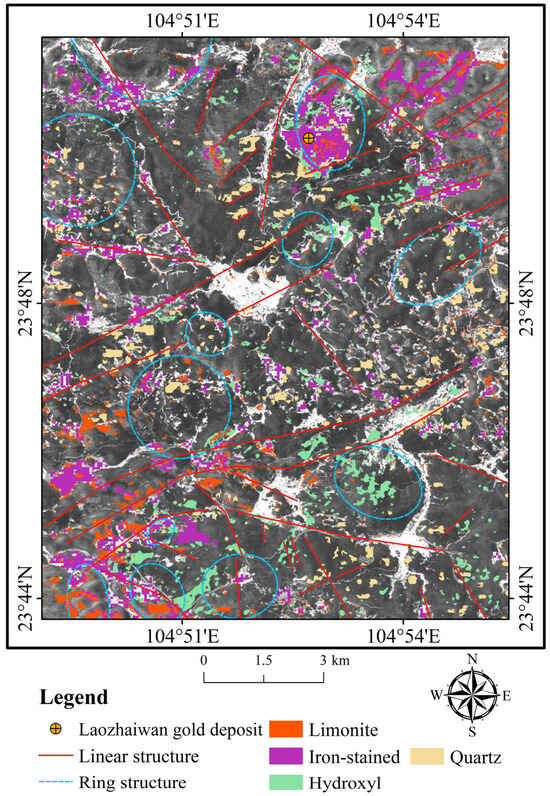
Figure 6.
Line-ring structural and mineralization alteration information results for the Laozhaiwan area.
The analysis of the structural and alteration information related to the Laozhaiwan gold deposit reveals key characteristics, based on which two prospecting potential areas were delineated within the study region, as shown in Figure 7. Prospecting Potential Area I is located in the western part of the study area, with lithology consisting of the Lower-Middle Devonian Pojiao Formation. Two NW-trending linear structures intersect here, and an annular structure in the southeastern part of the area intersects one of the linear structures. This area shows concentrated iron-stained and silicification alteration, along with the presence of hydroxyl and limonite alteration, indicating favorable metallogenic conditions. Prospecting Potential Area II is situated in the southwestern part of the study area, with the same lithology as the Lower-Middle Devonian Pojiao Formation. Three NW-trending linear structures pass through this region, which is also characterized by several well-developed ring structures. Three annular structures were identified, two of which intersect with an NW-trending linear structure. Iron-stained, limonite, and hydroxyl alteration are concentrated here, with some evidence of distribution along the NW-trending linear structures, and silicification alteration is also observed, suggesting this area also has favorable conditions for mineralization.
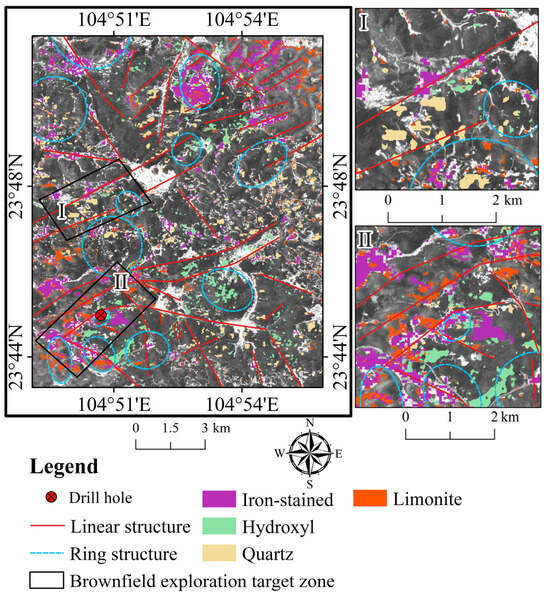
Figure 7.
Multi-source remote sensing mineral exploration prediction map for the Laozhaiwan area. I, Prospecting Potential Area I; II, Prospecting Potential Area II.
5. Discussion
5.1. Analysis of Remote Sensing Work Accuracy
To validate the effectiveness of the results, field investigations and exploration activities were conducted in Prospecting Area II. It was found that the exposed strata in the area had undergone significant weathering, mainly consisting of siltstone and mudstone, with occurrences of quartz sandstone discovered during field surveys. A total of 40 rock samples were collected from different field locations (Figure 8). Some of these samples exhibited signs of limonite, which closely corresponded with the mineralization and alteration information extracted from remote sensing data. Spectral measurements of the collected rock samples were performed using a CSD350A spectrometer. This equipment is manufactured by Nanjing Zhongdi Instruments Co., Ltd., Nanjing, Jiangsu Province, China. Pearson correlation analysis was conducted to compare the field spectra with standard USGS spectral curves (Table 5). The results showed a high degree of correlation between the collected samples and the USGS standard spectra, further verifying the reliability of the remote sensing technology.
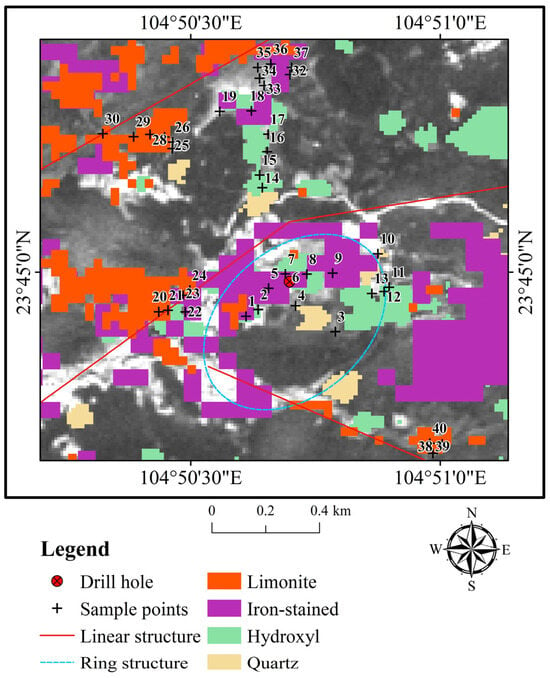
Figure 8.
Fieldwork in prospecting potential area.

Table 5.
Pearson correlation coefficient analysis.
Based on the remote sensing data and field validation results, a drilling site was deployed in this area, and the collected rock samples were used to prepare thin sections for petrographic identification (Figure 9). The petrographic analysis revealed strong alteration features in the region, including silicification (Figure 10a,b), pyritization (Figure 10e,f), limonitization (Figure 10c,d), and sericitization (Figure 10b). Additionally, quartz veins were observed, consistent with the iron-stained, hydroxyl, and silicification information extracted from remote sensing data. Notably, the gold grade in this borehole reached up to 5.3 g/t, indicating that the multi-source remote sensing extraction technology provides a valuable indication for guiding field prospecting work. Due to fieldwork limitations, Prospecting Potential Area I was not surveyed during this phase. Further field investigations are still required for that area.

Figure 9.
Drilling verification of prospecting potential area. (a,b) Drill hole field photos; (c–f) Core samples.
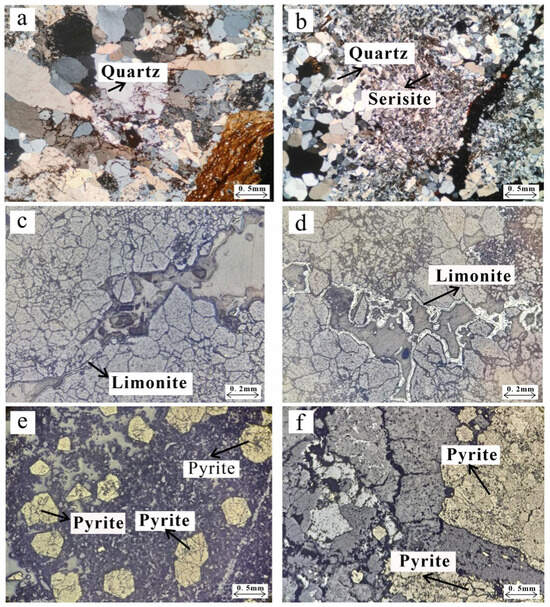
Figure 10.
The petrographic study of hydrothermal alteration minerals in Prospecting Potential Area II under the microscope, including (a) quartz veins, (b) metamorphosed fine-grained siliciclastic quartz sandstone, (c) silicified limonite mineralized quartz sandstone, (d) silicified quartz sandstone, (e) gray-black pyrite mineralized siltstone, and (f) dark gray clayey siltstone.
5.2. Analysis of Multi-Source Remote Sensing Application in Mineral Exploration
Compared to traditional geological methods, remote sensing information extraction techniques not only effectively capture structural information that is difficult to identify under microscopic conditions but also enable the rapid, large-scale extraction of alteration information. These techniques offer significant economic and social benefits by enhancing exploration efficiency and reducing costs [69,70,71]. Using multispectral data allows for the extraction of overall characteristics of structural trends and alteration distribution within the study area. However, it often includes areas such as exposed bedrock, talus piles, or Quaternary sandy soils and gravel zones, which may be misidentified. On the other hand, hyperspectral data provides continuous spectral curves of surface materials, allowing for a more in-depth analysis of alteration minerals’ spectral characteristics. This enables the fine and precise classification of alteration minerals. By conducting a comprehensive analysis of multi-source remote sensing alteration information extraction results, more accurate delineation of prospecting areas can be achieved, providing technical and theoretical support for field exploration efforts. This study integrates the alteration information extraction results from both multispectral and hyperspectral data. It reveals that in most areas, the iron-stained alteration information extraction results are well coupled. In the southwest and west of the study area, the alteration anomalies are predominantly clustered in a patchy pattern. Additionally, the limonite information extracted from hyperspectral data has a relatively larger distribution area in the southwest of the study area. This study, based on the alteration anomaly distribution characteristics and geological data of the study area, delineates two prospecting potential areas. The corresponding alteration information overlay and prospecting potential areas delineation results are shown in Figure 7.
The distribution of mineral deposits and alteration information anomalies in this area is primarily controlled by linear and ring structures. According to existing geological data and field surveys, these linear and ring structures are directly controlled by regional large faults, serving as conduits for mineral fluid migration and mineral deposition. Additionally, favorable mineral-bearing strata are an important indicator of fine-grained disseminated gold deposits. Since the mineralizing substances of carlin-type gold deposits primarily originate from sedimentary strata, the Middle Triassic Ban-na Formation and the Lower-Middle Devonian Pojiao Formation are the main gold-bearing horizons in the region. Furthermore, areas with good permeability and mineralized rocks (mainly clastic rocks, fine clastic rocks, and impure carbonates) are favorable for exploration.
Therefore, in the future, high spatial resolution data and radar data can be used for a more in-depth interpretation of the regional geological structures. Moreover, inversion techniques can be applied to invert regional lithology, obtaining more detailed stratigraphic and lithological information. This will enable the construction of a remote sensing prospecting system combining stratigraphy, lithological features, structural characteristics, and alteration information.
6. Conclusions
This study focused on the Laozhaiwan area in southeastern Yunnan Province, utilizing Sentinel-2A data to conduct interpretation and analysis of the spatial distribution characteristics of linear and ring structures. Through remote sensing image enhancement processing and visual interpretation techniques, a total of 50 linear structures and 12 ring structures were identified, showing good consistency with existing geological data. Multi-spectral data (Sentinel-2A and ASTER) were employed to extract iron-stained, hydroxyl, and silicification alteration information, while ZY1-02D hyperspectral data were used to map limonite alteration information. By comprehensively analyzing the remote sensing interpretation results of geological structures and alteration information, two prospective mineral exploration targets were delineated within the study area.
Field investigations and laboratory analyses were conducted on Target Area II, including 40 rock sample collection, spectral measurements using a CSD350A spectroradiometer, Pearson correlation coefficient analysis, and thin section identification. The results revealed intense alteration phenomena with high consistency to mineralization-related alterations, and the gold grade reached up to 5.3 g/t, demonstrating that the multi-source remote sensing approach can effectively reflect various alteration features and structural information. The integrated remote sensing data provide valuable guidance for field exploration and show strong potential in mineral resource prospecting.
However, this study has some limitations. The relatively low accuracy of stratigraphic and lithological information may lead to misinterpretations of geological formations. Additionally, the relationship between linear-ring structures and mineralization was analyzed only through spatial overlay without incorporating regional tectonic evolution to discuss fluid migration pathways. Future research could (1) utilize the Google Earth Engine (GEE) platform to acquire high-resolution remote sensing data and perform lithological classification based on machine learning, obtaining more precise stratigraphic information; (2) establish a temporal sequence model of “tectonic activity stage—hydrothermal location—alteration zoning” by incorporating regional geochronological data to develop a more robust remote sensing-based mineral exploration framework.
Author Contributions
Q.C.: conceptualization, methodology, writing—original draft. D.C.: resources, writing—review and editing, supervision, project administration. Z.Z.: supervision, project administration, resources. X.Y.: validation, investigation. Y.W. (Yilong Wang): validation, investigation. X.J.: validation, investigation. L.X.: validation, investigation. H.D.: validation, investigation. Y.H.: validation, investigation. X.Z.: resources. Y.W. (Yiyang Wang): resources. T.X.: supervision. All authors have read and agreed to the published version of the manuscript.
Funding
This research was supported by the “Yunnan Fundamental Research Projects” (Grant No. 202401CF070183), “the Scientific Research Foundation of Yunnan Province Education Department” (Grant No. 2024Y010), and the “National Natural Science Foundation of China” (Grant No. 42202329 and No. 41872251).
Data Availability Statement
In this research, the Sentinel-2A multispectral data was downloaded from the European Space Agency (ESA) (https://dataspace.copernicus.eu/, accessed on 27 January 2025), with one scene from 27 April 2024. The ASTER multispectral data was downloaded from the US Earthdata website (https://search.earthdata.nasa.gov/, accessed on 12 February 2025), with one scene from 20 November 2003.
Acknowledgments
We are grateful to the anonymous reviewers and editors for their critical and constructive review of this manuscript.
Conflicts of Interest
The authors declare that there is no conflict of interest.
References
- Wang, S.C.; Wang, J. Evolution and Prospects of the Strategic Significance of Gold. Econ. Land Resour. China 2019, 32, 33–37. (In Chinese) [Google Scholar]
- Wang, M.C.; Li, Z.X.; Mao, Y.L.; Shu, P.H. Geological features and genesis of the Laozhaiwan gold deposit in southeastern Yunnan Province. Geol. Explor. 2011, 47, 261–267. (In Chinese) [Google Scholar]
- Luo, G.; Yang, X.F. Geological characteristics and metallogenic regularity of fine disseminated type gold deposit at Laozhaiwan in Guangnan area, Yunnan, China. Geol. Bull. China 2010, 29, 1362–1370. (In Chinese) [Google Scholar]
- Dong, P. A test study on alteration mapping using Landsat TM data and geographic information system. In Methodology and Practice of Remote Sensing for Mineral Exploration; Science Press: Beijing, China, 1995; pp. 24–28. [Google Scholar]
- Pour, A.B.; Hashim, M.; van Genderen, J. Detection of hydrothermal alteration zones in a tropical region using satellite remote sensing data: Bau gold field, Sarawak, Malaysia. Ore Geol. Rev. 2013, 54, 181–196. [Google Scholar] [CrossRef]
- Swayze, G.A.; Clark, R.N.; Goetz, A.F.H.; Livo, K.E.; Breit, G.N.; Kruse, F.A.; Sutley, S.J.; Snee, L.W.; Lowers, H.A.; Post, J.L. Mapping advanced argillic alteration at cuprite, Nevada, using imaging spectroscopy. Econ. Geol. 2014, 109, 1179–1221. [Google Scholar] [CrossRef]
- Zhao, Z.F.; Zhou, J.X.; Lu, Y.X.; Chen, Q.; Cao, X.M.; He, X.H.; Fu, X.H.; Zeng, S.H.; Feng, W.J. Mapping alteration minerals in the Pulang porphyry copper ore district, SW China, using ASTER and WorldView-3 data: Implications for exploration targeting. Ore Geol. Rev. 2021, 134, 104171. [Google Scholar] [CrossRef]
- Chen, Q.; Zhao, Z.F.; Xia, J.S.; Zhao, X.; Yang, H.Y.; Zhang, X.L. Improving the accuracy of hydrothermal alteration mapping based on image fusion of ASTER and Sentinel-2A data: A case study of Pulang Cu deposit, Southwest China. Geocarto Int. 2022, 37, 13923–13948. [Google Scholar] [CrossRef]
- Wu, X.T.; Chen, H.; Zhang, X.F.; Wang, J.L.; Yu, B.; Feng, Y.L.; Dai, J.J. Extraction of mineralization elements and delineation of prospecting targets using multi-source remote sensing satellite data in vegetation-covered areas: A case study of the Yimen area, Yunnan Province. Geol. Explor. 2025, 61, 268–278. (In Chinese) [Google Scholar]
- Zhang, G.; Zhao, Z.F.; Zhang, X.L.; Wu, X.T.; Zheng, Y.F.; Feng, L.X.; Huang, Z.Q. Comprehensive Multi-Source remote sensing data integration for enhanced mineralization alteration extraction and geological structure interpretation in the Lala region of Sichuan Province. Ore Geol. Rev. 2024, 168, 106032. [Google Scholar] [CrossRef]
- Hu, Z.H.; Tang, J.X.; Zhang, T.B.; Wu, H.; Xu, Z.Z.; Bei, X.J. Characteristics of Remote Sensing Alternation Anomalies form ASTER in the Duobuza Porphyry Copper Deposit. Remote Sens. Nat. Resour. 2012, 24, 150–154. (In Chinese) [Google Scholar]
- Zhang, T.; Yi, G.; Li, H.; Wang, Z.; Tang, J.; Zhong, K.; Li, Y.; Wang, Q.; Bie, X. Integrating Data of ASTER and Landsat-8 OLI (AO) for Hydrothermal Alteration Mineral Mapping in Duolong Porphyry Cu-Au Deposit, Tibetan Plateau, China. Remote Sens. 2016, 8, 890. [Google Scholar] [CrossRef]
- Feng, Y.L.; Dai, J.J.; Bai, L.Y.; Wu, C.Y. Prospecting Prediction for the Yulong Metallogenic Belt in Tibet Based on Remote Sensing Alteration Information and Structural Interpretation. Remote Sens. 2024, 16, 1343. [Google Scholar] [CrossRef]
- Chen, Q.; Cai, D.Y.; Xia, J.S.; Zeng, M.; Yang, H.Y.; Zhang, R.S.; He, Y.; Zhang, X.X.; Chen, Y.; Zhao, Z.F. Remote sensing identification of hydrothermal alteration minerals in the Duobuza porphyry copper mining area in Tibet using WorldView-3 and GF-5 data: The impact of spatial and spectral resolution. Ore Geol. Rev. 2025, 180, 106573. [Google Scholar] [CrossRef]
- Sabins, F.F. Remote sensing for mineral exploration. Ore Geol. Rev. 1999, 14, 157–183. [Google Scholar] [CrossRef]
- Leverington, D.W.; Moon, W.M. Landsat-TM-Based discrimination of Lithological units associated with the Purtuniq ophiolite, Quebec, Canada. Remote Sens. 2012, 4, 1208–1231. [Google Scholar] [CrossRef]
- Zhang, Y.J.; Zeng, Z.M.; Chen, W. The methods for extraction of alteration alteration from the ETM + (TM) data and their application: Method selection and technological flow chart. Remote Sens. Land Resour. 2003, 2, 44–49. [Google Scholar]
- Nguyen, H.C.; Jung, J.; Lee, J.; Choi, S.U.; Hong, S.Y.; Heo, J. Optimal atmospheric correction for above-ground forest biomass estimation with the ETM+ remote sensor. Sensors 2015, 15, 18865–18886. [Google Scholar] [CrossRef] [PubMed]
- Pour, A.B.; Hashim, M. The application of ASTER remote sensing data to porphyry copper and epithermal gold deposits. Ore Geol. Rev. 2012, 44, 1–9. [Google Scholar] [CrossRef]
- Chen, Q.; Zhao, Z.; Jiang, Q.; Zhou, J.-X.; Tian, Y.; Zeng, S.; Wang, J. Detecting subtle alteration information from ASTER data using a multifractal-based method: A case study from Wuliang Mountain. SW China. Ore Geol. Rev. 2019, 115, 103182. [Google Scholar] [CrossRef]
- Wu, C.Y.; Dai, J.J.; Zhou, A.; He, L.; Tian, B.; Lin, W.H.; Zhao, T.C.; Bai, L.Y. Mapping alteration zones in the Southern section of Yulong copper belt, Tibet using multi-source remote sensing data. Front. Earth Sci. 2023, 11, 1164131. [Google Scholar] [CrossRef]
- Courba, S.; Youssef, H.; Jamal, A.; Abdessalam, O.; Mohamed, E.A.; Larbi, B.; Assia, I.; Zineb, A.; Slimane, S.; Lahcen, O.; et al. Litho-structural and hydrothermal alteration mapping for mineral prospection in the Maider basin of Morocco based on remote sensing and field investigations. Remote Sens. Appl. Soc. Environ. 2023, 31, 100980. [Google Scholar] [CrossRef]
- Yang, D.Y.; Shao, H.X.; Chang, H.L.; Zhang, R.X.; Ding, B.Z. Landsat 8 and ASTER remote sensing data for ore prospecting in the postmasburg manganese ore field, South Africa. Earth Sci. Inform. 2025, 18, 102. [Google Scholar] [CrossRef]
- Lima, T.A.; Beuchle, R.; Langner, A.; Grecchi, R.C.; Griess, V.C.; Achard, F. Comparing Sentinel-2 MSI and Landsat 8 OLI imagery for monitoring selective logging in the Brazilian Amazon. Remote Sens. 2019, 11, 961. [Google Scholar] [CrossRef]
- Wang, D.; Chen, J.P.; Dai, X. Extracting geological and alteration information and predicting antimony ore based on multisource remote sensing data in Huangyangling, Xinjiang. Front. Earth Sci. 2024, 12, 1366727. [Google Scholar] [CrossRef]
- Sun, Y.; Tian, S.; Di, B. Extracting mineral alteration information using Worldview-3 data. Geosci. Front. 2017, 8, 1051–1062. [Google Scholar] [CrossRef]
- Chen, Q.; Zhao, Z.; Zhou, J.; Zeng, M.; Xia, J.; Sun, T.; Zhao, X. New insights into the Pulang porphyry copper deposit in southwest China: Indication of alteration minerals detected using ASTER and WorldView-3 data. Remote Sens. 2021, 13, 2798. [Google Scholar] [CrossRef]
- Zhang, G.; Chen, Q.; Zhao, Z.F.; Zhang, X.L.; Chao, J.Q.; Zhou, D.Y.; Chai, W.; Yang, H.Y.; Lai, Z.B.; He, Y. Nickel grade inversion of lateritic Nickel ore using WorldView-3 data incorporating geospatial location information: A case study of north Konawe, Indonesia. Remote Sens. 2023, 15, 3660. [Google Scholar] [CrossRef]
- Chen, Q.; Zhao, Z.F.; Zhou, J.X.; Zhu, R.F.; Xia, J.S.; Sun, T.; Zhao, X.; Chao, J.Q. ASTER and GF-5 satellite data for mapping hydrothermal alteration minerals in the Longtoushan Pb–Zn deposit. SW China. Remote Sens. 2022, 14, 1253. [Google Scholar] [CrossRef]
- Liu, Y.N.; Sun, D.X.; Hu, X.N.; Ye, X.; Li, Y.D.; Liu, S.F.; Cao, K.Q.; Chai, M.Y.; Zhou, W.Y.N.; Zhang, J.; et al. The advanced hyperspectral imager: Aboard China’s GaoFen-5 satellite. IEEE Geosci. Remote Sens. Mag. 2019, 7, 23–32. [Google Scholar] [CrossRef]
- Dong, X.F.; Gan, F.P.; Li, N.; Yan, B.K.; Zhang, L.; Zhao, J.Q.; Yu, J.C.; Liu, R.Y.; Ma, Y.N. Fine mineral identification of GF-5 hyperspectral image. Int. J. Remote Sens. 2020, 24, 454–464. [Google Scholar] [CrossRef]
- Van der Meer, F.D.; Van der Werff, H.M.A.; Van Ruitenbeek, F.J.A.; Hecker, C.A.; Bakker, W.H.; Noomen, M.F.; van der Meijde, M.; Carranza, E.J.M.; de Smeth, J.B.; Woldai, T. Multi-and hyperspectral geologic remote sensing: A review. Int. J. Appl. Earth Obs. Geoinf. 2012, 14, 112–128. [Google Scholar] [CrossRef]
- Goetz, A.F.H. Three decades of hyperspectral remote sensing of the Earth: A personal view. Remote Sens. Environ. 2009, 113, S5–S16. [Google Scholar] [CrossRef]
- Fan, Y.H.; Wan, Y.Q.; Wang, H.; Yang, X.K.; Liang, M.; Pan, C.J.; Zhang, S.P.; Wang, W.B.; Tan, F.R. Application of an airborne hyper-spectral survey system CASI/SASIin the gold-silver-lead-zinc ore district of Huaniushan, Gansu. China. Geol. Croat. 2021, 74, 73–83. [Google Scholar] [CrossRef]
- Canbaz, O.; Gürsoy, O.; Karaman, M.; Çalışkan, A.B.; Gokce, A. Hydrothermal alteration mapping using EO-1 Hyperion hyperspectral data in Kosedag, Central Eastern Anatolia (Sivas-Turkey). Arab. J. Geosci. 2021, 14, 2245. [Google Scholar] [CrossRef]
- Liu, L.; Feng, J.L.; Rivard, B.; Xu, X.L.; Zhou, J.; Han, L.; Yang, J.L.; Ren, G.L. Mapping alteration using imagery from the Tiangong-1 hyperspectral spaceborne system: Example for the Jintanzi gold province, China. Int. J. Appl. Earth Obs. Geoinf. 2018, 64, 275–286. [Google Scholar] [CrossRef]
- Li, N.; Dong, X.F.; Gan, F.P.; Yan, B.K. Application Evaluation of ZY-1-02D Satellite Hyperspectral Data in Geological Survey. Spacecr. Eng. 2020, 9, 186–191. (In Chinese) [Google Scholar]
- An, X.W. Intergrated information metallogenic prediction of Carlin-type gold in Fuyuan, Yunnan. Master’s Thesis, China University of Geosciences, Beijing China, 2011. [Google Scholar]
- Cheng, Z.Y.; Zhao, P.S. The Remote Sensing Alteration Information Extraction and Metallogenic Prognosis of the Boka Gold Deposit in Yunnan Province. Remote Sens. Nat. Resour. 2011, 23, 135–140. [Google Scholar]
- Zhang, J.; Su, Q.W.; Liu, X.F.; He, Z.H.; Zhou, Y.M.; Li, Z.; Zhao, K. Characteristics of geology and isotopic geochemistry of the Laozhaiwan gold deposit in southeastern Yunnan Province, China. Acta Petrol. Sin. 2014, 30, 2657–2668. (In Chinese) [Google Scholar]
- Zhou, Y.G. Geology, Geochemistry and Metallogenic Model of Carlin-type Gold Deposits in Southeast Yunnan Province, China. Ph.D. Thesis, Central South University, Changsha, China, 2009. (In Chinese). [Google Scholar]
- Yang, L.; Deng, J.; Groves, D.I.; Wang, Q.F.; Zhang, L.; Wu, W.; Qin, K.; Zhang, Q.Z. Recognition of two contrasting structural and mineralogical-gold mineral systems in the Youjiang basin, China-Vietnam: Orogenic gold in the south and Carlin-type in the north. Geosci. Front. 2020, 11, 21–38. [Google Scholar] [CrossRef]
- Jin, X.Y.; Zhao, J.X.; Feng, Y.X.; Hofstra, A.H.; Deng, X.D.; Zhao, X.F.; Li, J.W. Calcite U-Pb dating unravels the age and hydrothermal history of the giant Shuiyindong Carlin-type gold deposit in the Golden Triangle, South China. Econ. Geol. 2021, 116, 1253–1265. [Google Scholar] [CrossRef]
- Li, C.; Miu, Y.; Li, W.C.; Li, Y.C.; Zhang, Y.Q.; Li, S. Metallogenic Regularity and Metallogenic Model of Gold Deposits in Southeastern Yunnan. Geotecton. Metallog. 2025, 1–22. (In Chinese) [Google Scholar] [CrossRef]
- Marshall, M.; Belgiu, M.; Boschetti, M.; Pepe, M.; Stein, A.; Nelson, A. Field-level crop yield estimation with PRISMA and Sentinel-2. ISPRS J. Photogramm. Remote Sens. 2022, 187, 191–210. [Google Scholar] [CrossRef]
- Claverie, M.; Ju, J.; Masek, J.G.; Dungan, J.L.; Vermote, E.F.; Roger, J.C.; Skakun, S.V.; Justice, C. The Harmonized Landsat and Sentinel-2 surface reflectance data set. Remote Sens. Environ. 2018, 219, 145–161. [Google Scholar] [CrossRef]
- Dai, J.J.; Qu, X.M.; Xin, H.B. Extraction of Alteration Mineral Information Using ASTER Remote Sensing Data in Duolong area, Tibet, China. Geol. Bull. China 2010, 29, 752–759. [Google Scholar]
- Yao, F.J.; Zhang, Y.J.; Yang, J.M.; Geng, X.X. Application of ASTER remote sensing data to extraction of alterration zoning information from Dexing porphyry copper deposit. Miner. Depos. 2012, 31, 881–890. [Google Scholar]
- Pour, A.B.; Hashim, M.; Park, Y.; Hong, J.K. Mapping alteration mineral zones and lithological units in Antarctic regions using spectral bands of ASTER remote sensing data. Geocarto Int. 2018, 33, 1281–1306. [Google Scholar] [CrossRef]
- Pour, A.B.; Hashim, M.; Hong, K.J.; Park, Y. Lithological and alteration mineral mapping in poorly exposed lithologies using Landsat-8 and ASTER satellite data: North-eastern Graham Land, Antarctic Peninsula. Ore Geol. Rev. 2019, 108, 112–133. [Google Scholar] [CrossRef]
- Zhang, X.L.; Zhao, Z.F.; Chen, Q.; Chai, W.; Li, Z.Y.; Yang, H.Y.; Niu, L. Mapping hydrothermal alteration of the Pulang porphyry copper deposit, SW China, using ASTER and ZY1-02D satellite data. Ore Geol. Rev. 2023, 161, 16. [Google Scholar] [CrossRef]
- Ding, W.Q.; Ding, L.; Li, Q.T.; Li, J.X.; Zhang, L.Y. Lithium-Rich Pegmatite Detection Integrating High-Resolution and Hyperspectral Satellite Data in Zhawulong Area, Western Sichuan, China. Remote Sens. 2023, 15, 3969. [Google Scholar] [CrossRef]
- Wu, C.Y.; Dai, J.J.; Chen, W.; Jiang, B.; Wang, D.H.; Wang, C.L.; Wang, W.J.; Sun, H.Z.; Wang, Q.; Chen, W.; et al. Extraction of remote sensing alteration information and its ore prospecting indication in Sumochagan Obao fluorite mining area, Inner Mongolia. Miner. Depos. 2023, 42, 845–858. [Google Scholar]
- Han, L.L.; Ding, W.C.; Chen, X.H.; Liu, M.L.; Wang, Y.; Xu, S.L.; Zhang, D.; Cui, Y.J. Linear structure extraction and quantitative analysis of multi-source remote sensing information in West Junggar Basin. Geol. China 2019, 46, 1209–1223. (In Chinese) [Google Scholar]
- Tong, Y.X.; Li, X.S.; Yang, J.Q.; Wang, F.C.; Cao, S.Q.; Wei, J.L. Identification of alteration minerals and linear structures and prediction of metallogenic favorable area based on ZY 1-02D hyperspectral data. Geol. China 2025, 1–22. (In Chinese) [Google Scholar]
- Hunt, G.R. Visible and near-infrared spectra of minerals and rocks: I silicate minerals. Mod. Geol. 1970, 1, 283–300. [Google Scholar]
- Gan, F.P.; Wang, W.S.; Ma, G.N. Identification of Mineral Spectral Lineages Using Characteristic Spectral Bands in Hyperspectral Remote Sensing. Earth Sci. Front. 2003, 02, 445–454. (In Chinese) [Google Scholar]
- Zhang, C.Y.; Qin, Q.M.; Chen, L.; Wang, N.; Zhao, S.S. Research and development of mineral identification utilizing hyperspectral remote sensing. Opt. Precis. Eng. 2015, 23, 2407–2418. (In Chinese) [Google Scholar] [CrossRef]
- Lu, Y. Application of Hyperspectral Mineral Mapping Technology in Metallic Mineral and Oil-Gas Exploration. Ph.D. Thesis, China University of Geosciences, Beijing, China, 2018. (In Chinese). [Google Scholar]
- Chen, Q.; Zhao, Z.F.; Jiang, Q.G.; Tan, S.C.; Tian, Y.G. Identification of metamorphic rocks in Wuliangshan Mountains (Southwest China) using ASTER data. Arab. J. Geosci. 2018, 11, 311. [Google Scholar] [CrossRef]
- Zoheir, B.; El-Wahed, M.A.; Pour, A.B.; Abdelnasser, A. Orogenic gold in transpression and transtension zones: Field and remote sensing studies of the Barramiya-Mueilha Sector, Egypt. Remote Sens. 2019, 11, 2122. [Google Scholar] [CrossRef]
- Loughlin, W.P. Principal components analysis for alteration mapping. Photogramm. Photogramm. Eng. Remote Sens. 1991, 57, 1163–1169. [Google Scholar]
- Pour, B.A.; Hashim, M. Identification of hydrothermal alteration minerals for exploring of porphyry copper deposit using ASTER data, SE Iran. J. Asian Earth Sci. 2011, 42, 1309–1323. [Google Scholar] [CrossRef]
- Crosta, A.P.; Moore, J. Enhancement of Landsat Thematic Mapper imagery for residual soil mapping in SW Minais Gerais State, Brazil: A prospecting case history in Greenstone belt terrain. In Proceedings of the 7th ERIM Thematic Conference: Remote Sensing for Exploration Geology, Calgary, AB, Canada, 2–6 October 1989; pp. 1173–1187. [Google Scholar]
- Kruse, F.A.; Lefkoff, A.B. Knowledge-Based geologic mapping with imaging spectrometers. Remote Sens. Rev. 1993, 8, 3–28. [Google Scholar] [CrossRef]
- Lanfranchi, R.A.; Cruz, S.C.P.; Rocha, W.F. Application of remote sensing and reflectance spectroscopy to explore iron-enriched domains in the north region of the intracontinental sector of the Araçuaí West Congo Orogen. Ore Geol. Rev. 2021, 128, 103916. [Google Scholar] [CrossRef]
- Zadeh, M.H.; Honarmand, M. A remote sensing-based discrimination of high- and low-potential mineralization for porphyry copper deposits; a case study from Dehaj-Sarduiyeh copper belt, SE Iran. Eur. J. Remote Sens. 2017, 50, 332–342. [Google Scholar] [CrossRef]
- Jing, L.H.; Li, G.M.; Ding, H.F.; Zhao, J.; Li, J.X.; Zhang, X.N. Remote sensing prosecting, geological evaluation, and significant discovery of porphyry copper deposits in the middle-western segment of Bangonghu-Nujiang metallogenic belt, Tibet. Acta Petrol. Sinca 2025, 41, 362–382. (In Chinese) [Google Scholar]
- Salehi, T.; Tangestani, M.H. Large-scale mapping of iron oxide and hydroxide minerals of Zefreh porphyry copper deposit, usingWorldview-3 VNIR data in the Northeastern Isfahan, Iran. Int. J. Appl. Earth Obs. Geoinf. 2018, 73, 156–169. [Google Scholar]
- Pour, A.B.; Park, T.-Y.S.; Park, Y.; Hong, J.K.; Muslim, A.M.; Läufer, A.; Crispini, L.; Pradhan, B.; Zoheir, B.; Rahmani, O. Landsat-8, advanced spaceborne thermal emission and reflection radiometer, and WorldView-3 multispectral satellite imagery for prospecting copper-gold mineralization in the northeastern Inglefield Mobile Belt (IMB), Northwest Greenland. Remote Sens. 2019, 11, 2430. [Google Scholar] [CrossRef]
- Guha, A.; Yamaguchi, Y.; Chatterjee, S.; Rani, K.; Vinod Kumar, K. Emittance spectroscopy and broadband thermal remote sensing applied to phosphorite and its utility in geoexploration: A study in the parts of Rajasthan, India. Remote Sens. 2019, 11, 1003. [Google Scholar] [CrossRef]
Disclaimer/Publisher’s Note: The statements, opinions and data contained in all publications are solely those of the individual author(s) and contributor(s) and not of MDPI and/or the editor(s). MDPI and/or the editor(s) disclaim responsibility for any injury to people or property resulting from any ideas, methods, instructions or products referred to in the content. |
© 2025 by the authors. Licensee MDPI, Basel, Switzerland. This article is an open access article distributed under the terms and conditions of the Creative Commons Attribution (CC BY) license (https://creativecommons.org/licenses/by/4.0/).





